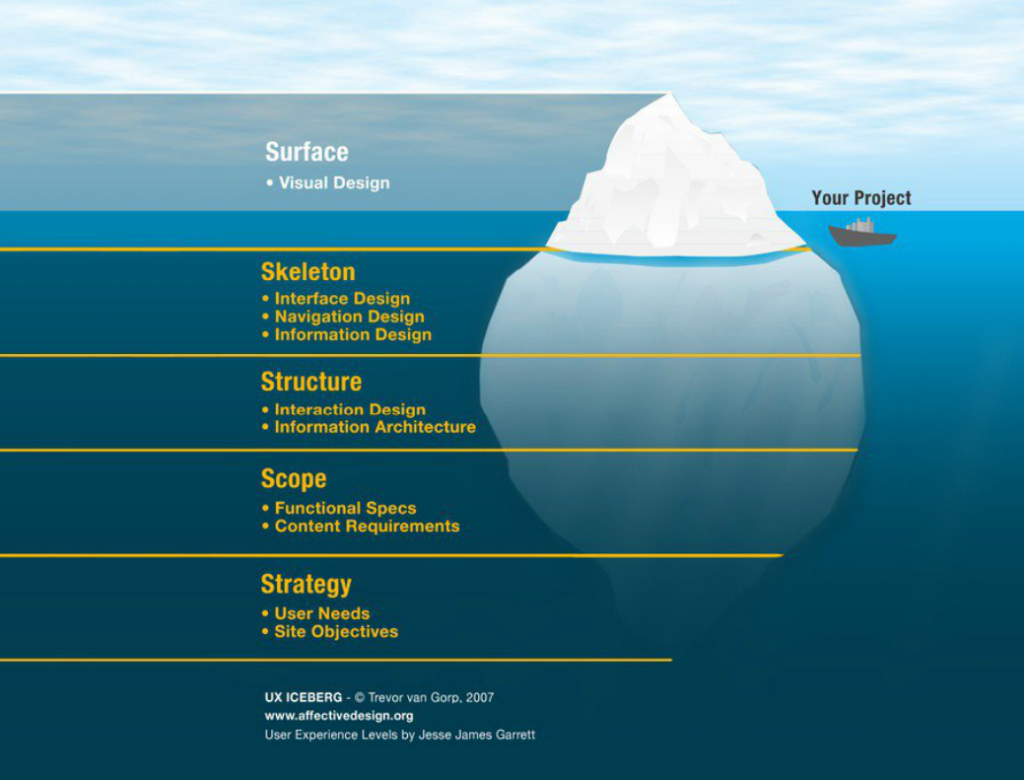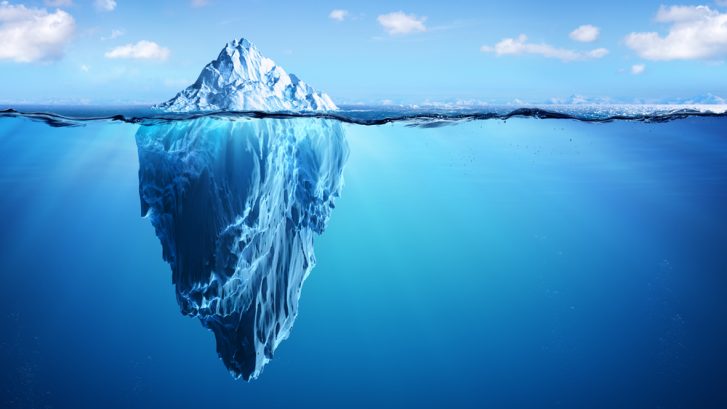Those who are inside the UX Design area certainly know the Iceberg of the User Experience. This illustration by Trevor van Gorp, inspired by Jesse James Garrett’s The Elements of User Experience, presents the 5 levels of the UX Design process or Iceberg. This graph shows which elements make up the good user experience: strategy, scope, structure, skeleton and surface.
The iceberg divides the UX Design process into different stages as long as it is always user-centered.
“Usability itself is just a large block of a UX Iceberg, as seen below, and a part of the overall user experience of products, whether physical (watches) or online (websites).” – Marko Nemberg, Sales and Marketing Manager at Trinidad Wiseman
Levels of the UX Design process

Trevor van Gorp iceberg
Strategy
This is the first part of the UX Design process, which is at the bottom of the iceberg. It has to do with trying to know the needs of the people who will interact with the product / service.
Only by knowing what the users’ needs are can we move on to the next levels. That is why strategy is at the bottom.
So this is the moment when you ask yourself:
- Why this product, application or website?
- Why your creation?
- Who is it being created for?
- Why will people be willing to use it?
- Why do they need it?
These questions can be answered through interviews or inquiries.
Scope
The second level of the UX Design process is to define the functional and content requirements for the product / service being developed.
Functional requirements: requisition to which the software should attend.
Content requirements: information necessary to give value to the consumer, such as texts, images, videos, audios, among others. It is essential to know the time needed to complete the project.
Structure
This third level is composed of two elements: Interaction Design and Information Architecture.
Interaction Design: taking into account the functional requirements, it is defined how the user can interact with the system interface and how it will respond to user interactions. Interaction Design allows:
- Help users achieve their goals;
- Communicate how interactions and functionalities work;
- Inform users about state changes while interaction takes place (when an action ends, gives feedback to the user).
Information Architecture: once the contents have been defined, it is necessary to define how they will be organized to facilitate usability and the understanding of the user. Information Architecture allows:
- That the data be organized, categorized and prioritized based on the user’s need and the objectives of the organization;
- Understanding users about what is happening at the interface;
- Flexibility of the structure;
- Let the information be shown in a simple way.
Skeleton
This level determines the visual form of the screen, the presentation and arrangement of all the elements necessary for the interaction to occur with an existing functionality in the interface. In addition, it is necessary to think about how the information will be presented to make it effective and easy to understand.
At this level wireframes are created, useful for creating a visual model of how the interface would look.
It is composed of three elements:
Interface design: how the interface elements will be organized and presented, to allow users to interact with the system;
Navigation design: how the user navigates the information;
Information design: how the information will be displayed, so as to facilitate the user’s understanding.
Therefore, at this stage the following questions should be raised:
- How will things be displayed on the screen?
- How will interactions be presented to the user and how will they be organized to facilitate understanding?
- How will users move around the application or website?
- How will the information be shown easily and clearly?
Surface
It is the level that is above others, because it is the “sum” of the work and decisions taken at previous levels. That’s when we determine how the layout, colors, typography, etc. will be. Basically, it is the visual design, that is, when we think about the visual appearance of the content, which shows how the users interact.
Each of these levels of the UX Design process depends on the level below to be able to materialize.


